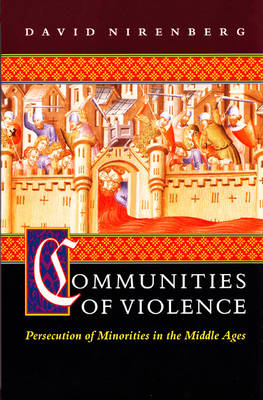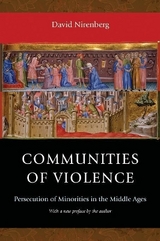
Communities of Violence
Persecution of Minorities in the Middle Ages
Seiten
1998
Princeton University Press (Verlag)
978-0-691-05889-4 (ISBN)
Princeton University Press (Verlag)
978-0-691-05889-4 (ISBN)
- Titel erscheint in neuer Auflage
- Artikel merken
Zu diesem Artikel existiert eine Nachauflage
Focuses on specific attacks against minorities in fourteenth-century France and the Crown of Aragon. This book argues that these attacks - ranging from massacres to verbal assaults against Jews, Muslims, lepers, and prostitutes - were often perpetrated by groups that manipulated and reshaped the available discourses on minorities.
In the wake of modern genocide, we tend to think of violence against minorities as a sign of intolerance, or, even worse, a prelude to extermination. Violence in the Middle Ages, however, functioned differently, according to David Nirenberg. In this provocative book, he focuses on specific attacks against minorities in fourteenth-century France and the Crown of Aragon (Aragon, Catalonia, and Valencia). He argues that these attacks - ranging from massacres to verbal assaults against Jews, Muslims, lepers, and prostitutes - were often perpetrated not by irrational masses laboring under inherited ideologies and prejudices, but by groups that manipulated and reshaped the available discourses on minorities. Nirenberg shows that their use of violence expressed complex beliefs about topics as diverse as divine history, kinship, sex, money, and disease, and that their actions were frequently contested by competing groups within their own society. Nirenberg's readings of archival and literary sources demonstrates how violence set the terms and limits of coexistence for medieval minorities.
The particular and contingent nature of this coexistence is underscored by the book's juxtapositions - some systematic (for example, that of the Crown of Aragon with France, Jew with Muslim, medieval with modern), and some suggestive (such as African ritual rebellion with Catalan riots). Throughout, the book questions the applicability of dichotomies like tolerance versus intolerance to the Middle Ages, and suggests the limitations of those analyses that look for the origins of modern European persecutory violence in the medieval past.
In the wake of modern genocide, we tend to think of violence against minorities as a sign of intolerance, or, even worse, a prelude to extermination. Violence in the Middle Ages, however, functioned differently, according to David Nirenberg. In this provocative book, he focuses on specific attacks against minorities in fourteenth-century France and the Crown of Aragon (Aragon, Catalonia, and Valencia). He argues that these attacks - ranging from massacres to verbal assaults against Jews, Muslims, lepers, and prostitutes - were often perpetrated not by irrational masses laboring under inherited ideologies and prejudices, but by groups that manipulated and reshaped the available discourses on minorities. Nirenberg shows that their use of violence expressed complex beliefs about topics as diverse as divine history, kinship, sex, money, and disease, and that their actions were frequently contested by competing groups within their own society. Nirenberg's readings of archival and literary sources demonstrates how violence set the terms and limits of coexistence for medieval minorities.
The particular and contingent nature of this coexistence is underscored by the book's juxtapositions - some systematic (for example, that of the Crown of Aragon with France, Jew with Muslim, medieval with modern), and some suggestive (such as African ritual rebellion with Catalan riots). Throughout, the book questions the applicability of dichotomies like tolerance versus intolerance to the Middle Ages, and suggests the limitations of those analyses that look for the origins of modern European persecutory violence in the medieval past.
David Nirenberg is Associate Professor of History and Director of the Center for the Study of Cultures at Rice University.
AcknowledgmentsAbbreviationsIntroduction3Ch. 1The Historical Background18Ch. 2France, Source of the Troubles: Shepherds' Crusade and Lepers' Plot (1320, 1321)43Ch. 3Crusade and Massacre in Aragon (1320)69Ch. 4Lepers, Jews, Muslims, and Poison in the Crown (1321)93Ch. 5Sex and Violence between Majority and Minority127Ch. 6Minorities Confront Each Other: Violence between Muslims and Jews166Ch. 7The Two Faces of Sacred Violence200Epilogue: The Black Death and Beyond231Bibliography of Works Cited251Index281
| Erscheint lt. Verlag | 15.2.1998 |
|---|---|
| Zusatzinfo | 2 Maps |
| Verlagsort | New Jersey |
| Sprache | englisch |
| Maße | 152 x 235 mm |
| Gewicht | 482 g |
| Themenwelt | Geschichte ► Allgemeine Geschichte ► Mittelalter |
| Geisteswissenschaften ► Geschichte ► Regional- / Ländergeschichte | |
| Geschichte ► Teilgebiete der Geschichte ► Kulturgeschichte | |
| Sozialwissenschaften ► Soziologie | |
| ISBN-10 | 0-691-05889-X / 069105889X |
| ISBN-13 | 978-0-691-05889-4 / 9780691058894 |
| Zustand | Neuware |
| Haben Sie eine Frage zum Produkt? |
Mehr entdecken
aus dem Bereich
aus dem Bereich
eine neue Geschichte des Mittelalters
Buch | Hardcover (2023)
C.H.Beck (Verlag)
CHF 53,20



